Dear Friends
It was the unsettling low roar that got my attention. When first perceived, my mind simply put it in the folder marked ‘wind in trees.’ But then the rational mind took over with a nagging thought: there were no trees on this part of the range. The nearest forest or creek-side aspen grove was miles away.
And that single truth was fairly dread-inspiring. The blackening skies didn’t help, either, punctuated with the brilliant spikes of lightning that pummeled the hills around us. Peals of thunder rolled and echoed off the peaks and valleys with a simultaneous white lightning display that indicated the storm was nearly upon us. And the continuous roar growled louder.
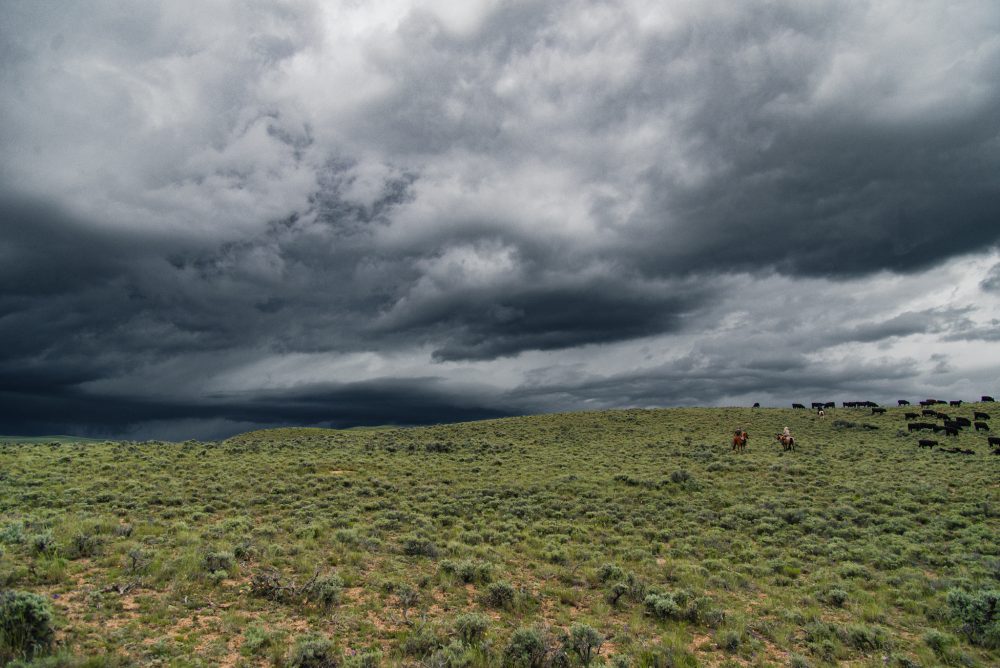
On the open ranges of the sagebrush ocean, there is no shelter. It is simply whether or not horse and rider are in an ocean trough or crest of the wave, akin to a draw or a ridge. And here, in Bear Basin, the troughs were not very deep. Lightning and wind could strike anywhere.
I was on the back of the Ruby mare, a striking red sorrel with a light flaxen blonde mane and tail that were now streaming horizontal in a chill wind descending from stratospheric heights out of the black-purple belly of a thunderhead. After 6 years with us on the broad ranges of Hat Creek, Ruby had gotten past most of her ‘pretty girl’ attitude and was finally willing to set to work. I felt her tighten a little under me with every lightning and thundery blast, but at least I felt she wasn’t going to cut, buck and run.
It was crew swap time, and I was riding on boss Linnaea’s crew. There were three of us that just left our white-canvas tented cow camp to find Melanie’s team out on the rolling tables of the Basin. We had an idea where they went, as we saw the distant pepper scatter of 450 plus black cattle from the summit of Big Deer Mountain on the truck ride in. After going over one ridge in their general direction, we met the first crew members on a hard trot back.
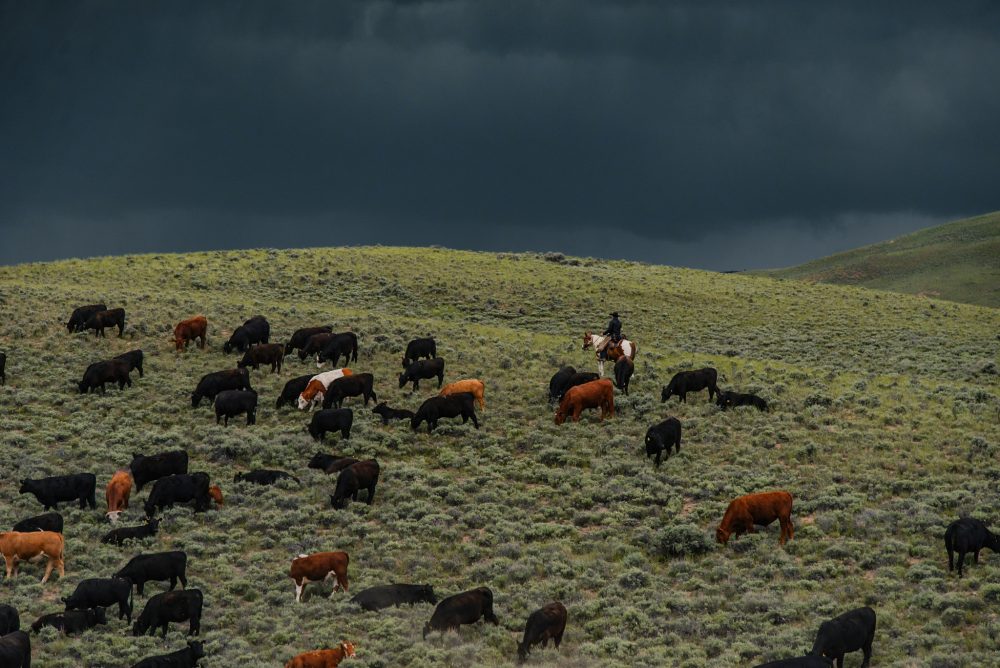
It was Melanie with Mason and Wesley, first year riders. They grinned despite incoming fury borne by black skies. Even after 4 long days on their stint, they were still happy. Mason gestured back: “The herd is about two ridges back. You’ll run into them. Brittany, Rachael and Maddy are still holding them together. Have a great ride!” We exchanged quick goodbyes and continued on our respective trails. In just another wave of sagey ocean, we spotted the herd, now safely bedded down in thick sage by Brittany, Maddy, and Rachael.
With a wave, Linnaea dismissed them as she took over. “Good to go!” she yelled over to them in an effort to be heard over the increasing wind. They immediately headed for camp and the waiting four-wheel drive. We all knew that time was of the essence; if we got a lot of rain with the incoming front, they might not be able to get back to the ranch for days. The roads could and would become quickly impassable with greasy volcanic clay muck. There would be no other way out but to wait until sun and drying weather.
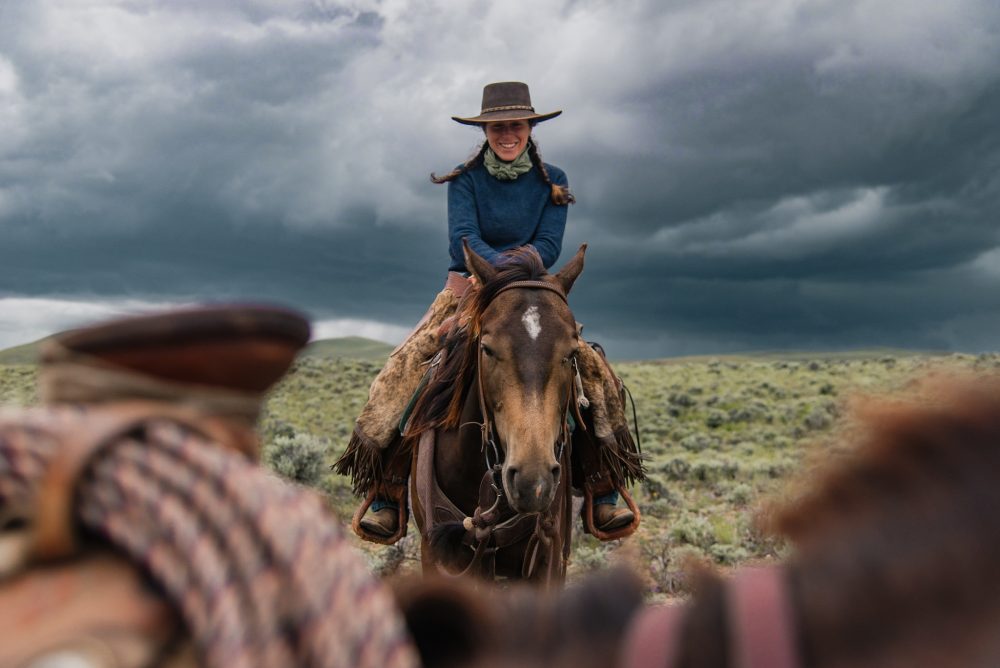
As we dropped down toward the cattle, a brilliant flash of 5 separate bolts exploded along the perimeter of the Bear Basin rim, just hundreds of yards away.
Memories of last summer in similar weather rushed into my mind; I had 5 riders up in Moose Creek last summer when lightning pounded the creek itself, just yards away from herd and cowhands. They weren’t on a ridge, but the nearby creek served as a conductor. They all experienced various symptoms of a light strike; some felt it, some heard crackly static sizzle or saw sparks or orbs on their gear or between their fingers. Everyone was fine, but it was scary close, and I didn’t want to go through that again.
I grabbed the walkie-talkie strapped to my leather vest. “Everyone off their horses!” I shouted into the mic. We all carried one, and I was grateful to Caryl for making us do it. She, of all of us, is the most safety minded and cost conscious. Efficiency-wise, radios are the best idea since sliced bread. It’s the perfect example of tech marriage to the ancient tradition of horseback herding. Here we are moving large herds of grazers across the landscape horseback as cultures worldwide have for millennia; we wear leather, iron and silk and oilskin. Yet we carry radios, GPS devices, digital maps on smartphones and use electric fence at night.
The radios are especially important this summer, as we are running larger and larger herds due to a dramatic increase of grass on regenerating rangelands, and riders often are well out of earshot from each other. Sometimes I spot crew members a mile apart, each handling the flank of a well dispersed herd. Â
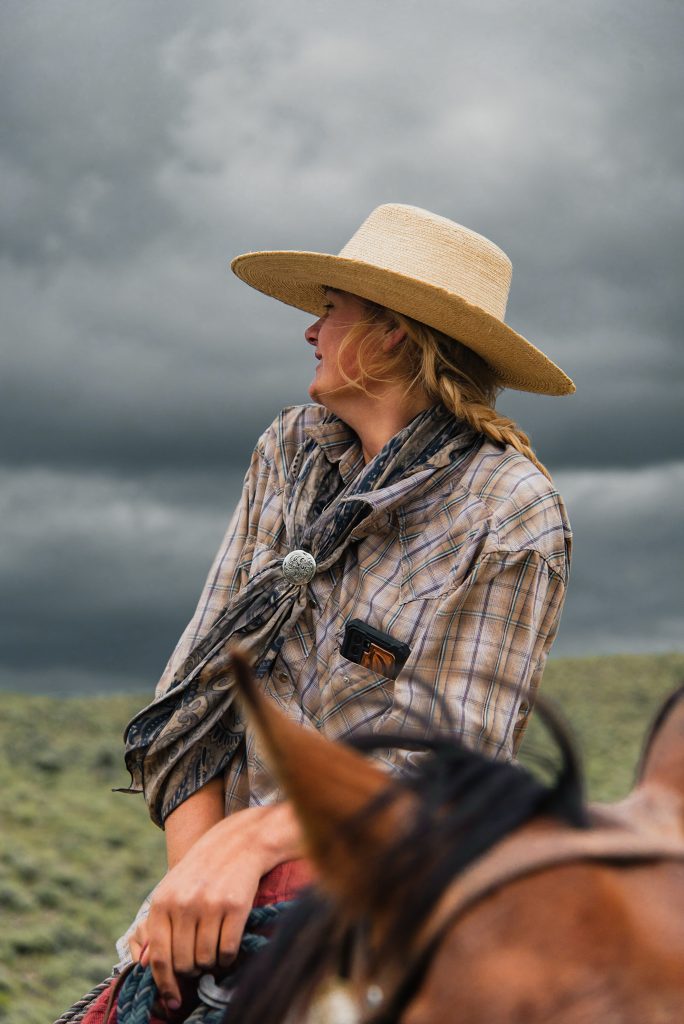
“Head for the draw bottoms! Get off the ridges!” I told them. The radio crackled back acknowledging words from the crew like ‘copy that,’ and ’10-4.’ It was all about changing your body position from the highest point to a lowest point. High point equals lightning rod, especially on horseback. Low point, hopefully, equals life and living for both horse and rider.
“Get away from each other, and stay away from tight groups of cattle!”
“10-4! Roger that!”
I recalled when a friend of mine lost 15 head of mother cows and calves to lightning as they lay clustered together on the top of a ridge in Baldy Basin, just 25 miles from here. The other 350 head were scattered over nearby ridge and dale. I looked over at Linnaea, Brittany, Nicole and Annie, each about 30 yards away. They were off their saddles, as I was, in this broad draw just below our 450 head of cattle, still bedded down, calmly chewing cud. The wind was whipping, drawing trailing tails of our horses out beyond us.
And the roar, now, was no longer background. “It must be rain!” I shouted to them. But that thought was dismissed immediately when the reason for the roar became immediately apparent.
A single marble-sized hailstone shot into the white soil at my feet. ‘Puff’ went a tiny dust cloud in the ash. I knew we were in trouble. “It’s HAIL! I yelled. Hang on to your horses!”
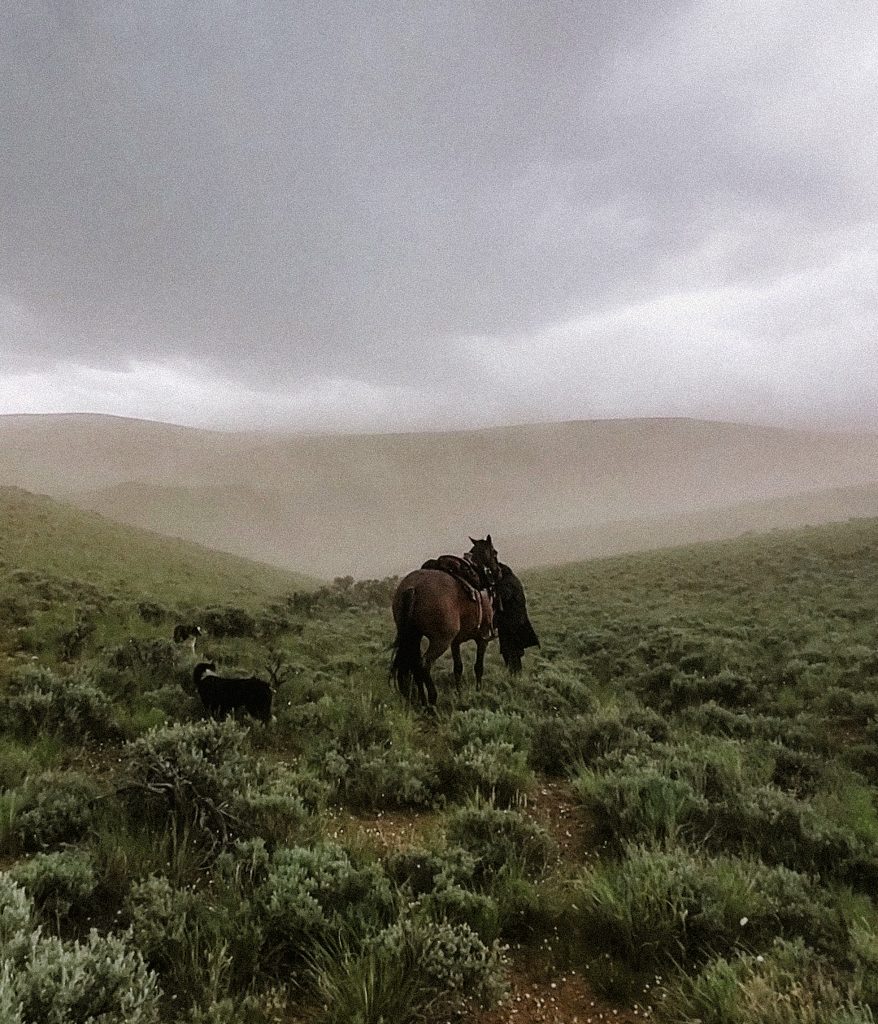
Linnaea quickly repeated the command on the radio to the still missing rest of our crew, and to Rachael, Maddy, and Brittany who were likely still en route to camp. To the west: an ominous curtain of gray gobbled up the landscape into obscurity.
We were in for it. Heavy oilskin canvas dusters came off saddle cantle, unrolled and unfurled in the frustratingly flapping wind and quickly button-snapped up. Their cloth was fairly bulletproof, even to hail, and kept even the most persistent rainfall out.
They came from tens of thousands of feet above. I’ve cut into hailstones before with pocketknife; like the layers in an onion, they are a frozen drop of water with layer after layer of ice built on to them. Each layer represents another trip upward into the freezing heights of a high reaching thunderhead; water coats the crystal as it heads earthward, and then huge uplifting updrafts of rising hot and moist air off of the Oregon deserts and Idaho mountain ranges send it skyward for a trip to 50 thousand feet where it immediately freezes in the frigid high altitude thin air. Then, ice crystal’s gravity weight exceeds the force of uplifting winds, and stone falls until wind exceeds gravity, once again, and the cycle repeats itself.
And that’s where it gets ugly. Those uplift winds can be super strong. They can toss even golf ball or, occasionally baseball sized hail upwards for another round trip. And that’s where hail becomes hellish, breaking windows, denting car roofs and causing injury to animal—and human.
We don’t hear of human being wounded very often in the news media chronicling word of hailstones and hurricanes. Why? Simply because humans take shelter, quickly. They see it and run for cover. Good idea.
Except in a place like Bear Basin. Not a tree, mind you. No buildings for 30 miles.
We leaned into the curtain when it came. It was light-switch immediate. Marble sized balls slammed into horse, human, cow and collie. Cows immediately ran for it, driven by the discontinuous sheet of ice, coming down at 70 miles per hour, frozen marbles falling from 40,000 feet.
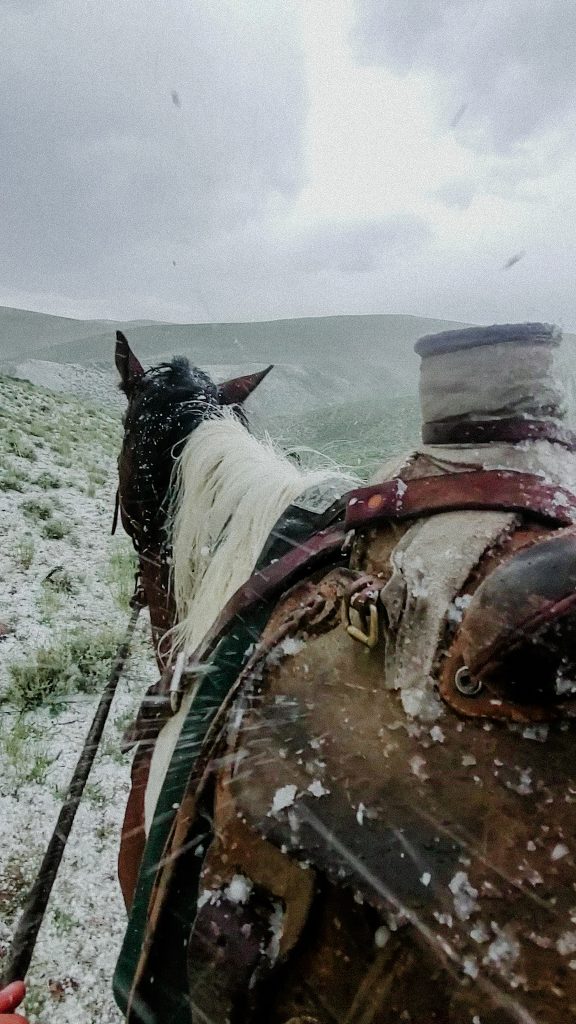
In a moment, beeves were gone over the next ridge, on the run down—away from the stones. Downwind, even though they could never escape. “Let them go!” I yelled, to no one person in particular. Not sure they heard me, I jumped on the radio with the same command.
Meanwhile, our horses pulled hard to follow suit in a mad dash for and from nothing. We held reins, halter ropes. Border collies bit the hail fruitlessly, desperately, barking for it to stop. One such pup, namely Stew-Jake angrily bit my legs and hands by accident as he literally combatted hail with tooth and nail. We each corralled one or two dogs and gathered them under our long canvas coats. They quickly learned that either there or under a horse was the only safe place.
The horses quickly found that there was nothing they could do, except turn butt and tail to wind and the drive of hailstones, and tuck their heads low. Some had experienced hail before, and although not happy, dealt with the continuous blows to their backs. Fur and mane protected them to some degree. Â The lightning, although continuous, no longer occupied their minds. It was replaced by stings of stones.
Our cowboy hats, made of thick felt, made a pretty solid barricade to pain. Melanie told me later she didn’t get her oilskin coat on fast enough on her mad dash back to camp to get out of the high country. She had black and blue bumps across her shoulders where the stones found their first contact after an eight mile freefall.
The storm lasted only 15 minutes, and thankfully, the stones never got much larger than marbles. And as fast as it arrived, it was gone.
The ground was white, despite it being June 21, and the fact that a steady rain followed it. Temps had dropped so much that even on this, the longest day of the year, snow fell deep on our ranges above the 7000-foot line.
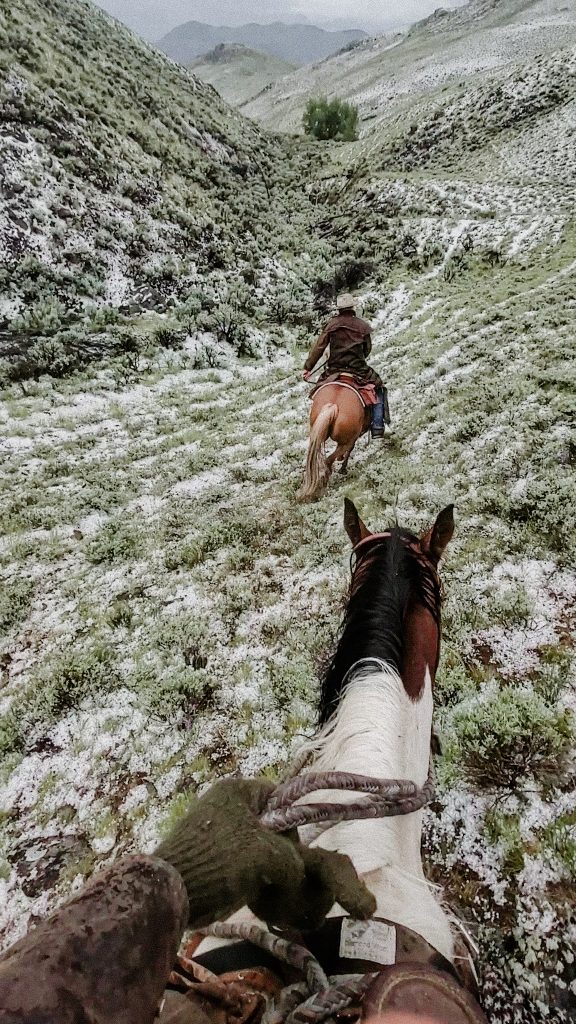
For the rest of that day, we put together our scattered herd of beeves under a steady drizzle of rain. The beeves happily went back to grazing in the cool and wet. Human crew, however, were stoic in the icy frontal shift to wet and cold and snowy just above the basin. It was 90 just the day before, and most of us weren’t ready psychologically and practically to deal with the near-freezing temperatures.
It’s like that so often on the range. Nature dishes out fury that is unexpected and potentially dreadful. We respond as best as we know, hoping we do the right thing. And for the most part, it works out. But it certainly keeps us humble. There’s no cocky in this country. Because when faced with everything from weather to wolves, we always find out just how vulnerable we are.
And that vulnerability is OK. It comes naturally in the territory of producing wild food; it makes it all worth it.
Happy Trails.

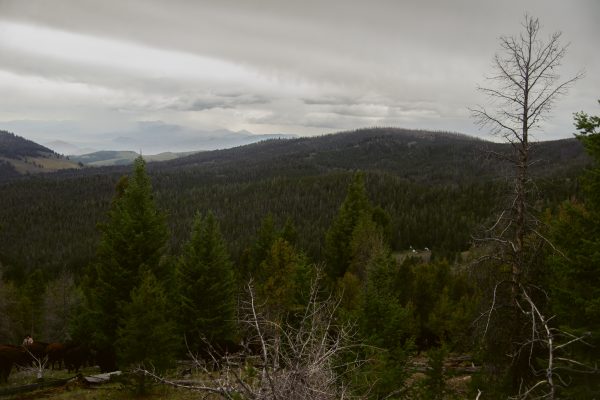

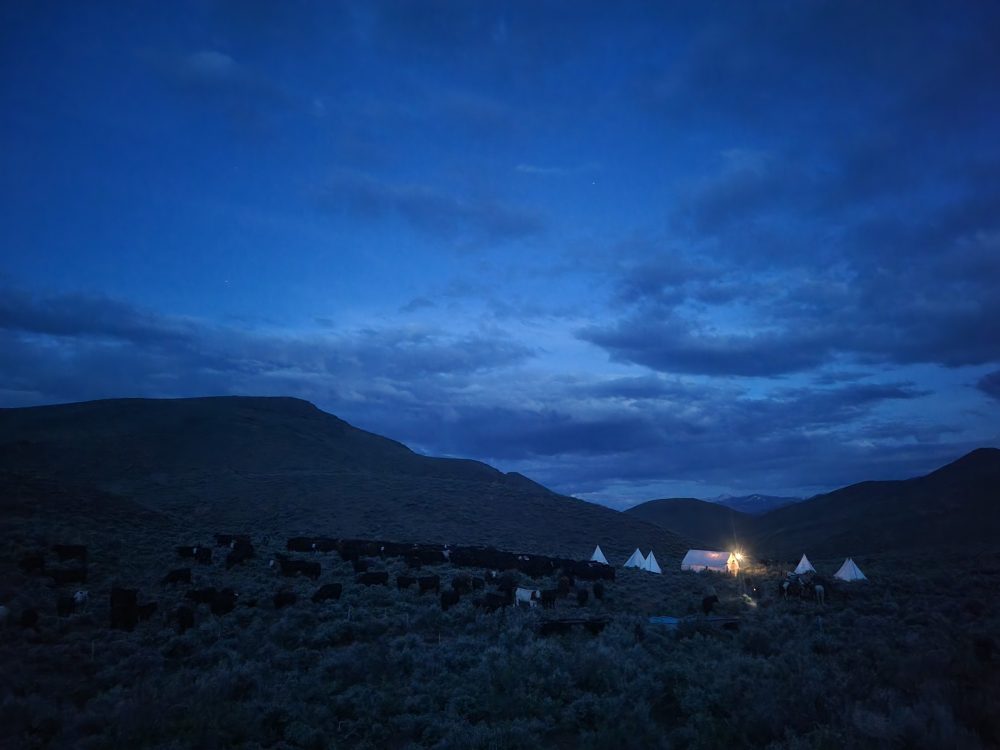
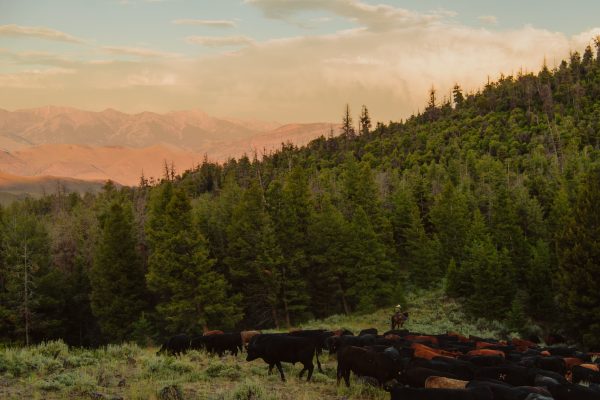
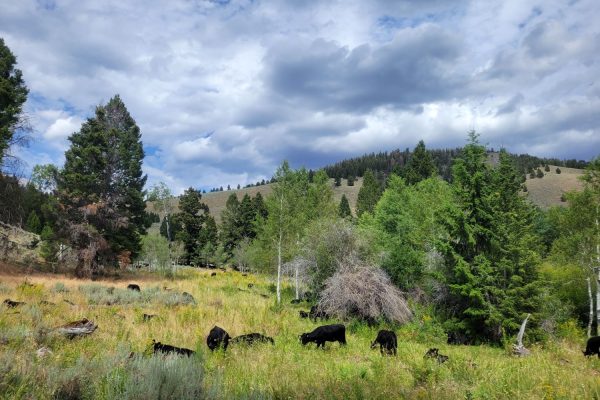

Dave
Your very well written accounts of life on the range, along with such beautiful photo illustrations, would make an award winning coffee table book!
Caryl Elzinga
Ha! Dave, it’s funny you mentioned it. A publisher and I have been talking…
Who knows?
possibilities!
Thanks, Dave. -glenn
Joan d'Entremont, Lynn, MA
Thank you so very much for sharing this story with us. It truly helps us to understand all that is involved in ranching. It is no easy task to grow excellent, healthy, wild meat
products as you are doing so marvelously. Thank you for all your hard work.
Caryl Elzinga
Joan. Fantastic that you took the time to write. thanks so much. When you’re in the middle of tumult, you wish it would end. But looking back, you almost always can say, “I wouldn’t have had it any other way.” Because we learn about the strength and beauty of nature.
-Glenn
Paula
I should have been one of you but life didn’t give me that option. I love how you love and consider the land and soil. It is right and godly to do so and respects what has been given us. I request you look into being EBT acceptable because I live in a neighborhood where a number of moms are concerned ab out what their children are eating. We, meaning these EBT customers will not be a major order, but we can split costs and serve our children what every child deserves whether rich or poor. I hope you are open to this idea. I know you don’t need poor people to buy your product. Sure you have lots of rich people who afford you. Just asking and hope you consider. If you don’t consider, please give kindness and courtesy of why you cannot consider EBT consumers.
Caryl Elzinga
Paula
Thanks for your kind note. I will have Kelsey check into it to see what it takes! thanks for the thoughts!
Glenn